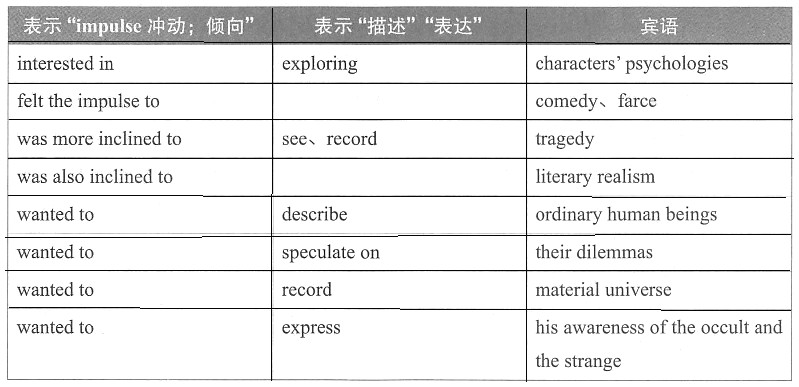[考点] 细节的目的
[解析]
1.做题分析 ①
The evolution of intelligence among early large mammals of the grasslands was due in great measure to the
interaction between two ecologically synchronized groups of these animals, the hunting carnivores and the herbivores that they hunted. ②The interaction resulting from the differences between predator and prey
led to a general improvement in brain functions;
however,
certain components of intelligence were improved far more than others. ③
The kind of intelligence favored by the interplay of increasingly smarter catchers and increasingly keener escapers is defined by attention —that aspect of mind carrying consciousness forward from one moment to the next.④
It ranges from a passive, free-floating awareness to a highly focused, active fixation.⑤The range through these states
is mediated by the arousal system, a network of tracts converging from sensory systems to integrating centers in the brain stem.⑥From the more relaxed to the more vigorous levels, sensitivity to novelty is increased. ⑦The organism is more awake, more vigilant; this increased vigilance results in the apprehension of
ever more subtle signals as the organism becomes more sensitive to its surroundings.⑧The processes of arousal and concentration give attention its direction. ⑨
Arousal is at first general, with
a flooding of impulses in the brain stem; then gradually the
activation is channeled. ⑩Thus begins concentration, the holding of consistent images.
⑪One meaning of intelligence is the way in which these images and other alertly searched information are used in the context of previous experience.⑫Consciousness
links past attention to the present and
permits the integration of details with perceived ends and purposes. ⑬The elements of intelligence and consciousness come together marvelously to produce different styles in predator and prey.⑭Herbivores and carnivores
develop different kinds of attention related to escaping or chasing.
⑮Although in both kinds of animal, arousal
stimulates the production of adrenaline and norepinephrine by the adrenal glands,
the effect in herbivores is primarily fear,
whereas in carnivores the effect is primarily aggression.⑯For both, arousal attunes the animal to what is ahead.
⑰Perhaps it does not experience forethought as we know it, but the animal does experience something like it.
⑱The predator is searchingly aggressive, inner-directed, tuned by the nervous system and the adrenal hormones,
but aware in a sense closer to human consciousness than, say, a hungry lizard's instinctive snap at a passing beetle.
⑲Using past events as a framework, the large mammal predator is working out a relationship between movement and food, sensitive to possibilities in cold trails and distant sounds—and yesterday's unforgotten lessons.
⑳The herbivore prey is of a different mind.

Its mood of wariness rather than searching and its attitude of general expectancy instead of anticipating are silk-thin veils of tranquillity over an explosive endocrine system.
2.文章结构 文章比较难,全文和每个段落都呈现总一分结构。第一段在整体上作为背景引入,讲述捕食者和被捕食者的关系导致双方智力的某一方面不断发展;第二段讲述这种智力的进步主要表现为注意力,以及它的发展过程;第三段讲述智力发展在捕食者和被捕食者中的不同形式。段内句子之间多次使用指代,非常连贯,各个事物之间的关系解释得非常清楚。但是文章出现了一些长难句和生词,而且出现了不少不太好理解的专业术语,增大了阅读理解的难度。
第一段: 背景:早期哺乳动物的智力进化是通过食肉动物和食草动物的相互作用实现的。
主题:智力的某些方面会比其他方面得到更多的发展。
第二段: 主题:这种因为捕食者和被捕食者相互作用而发展的智力主要体现在注意力上。
细节1:注意力变化的阶段。
细节2:注意力变化对生物的影响。
细节3:注意力的变化为什么可以称为智慧。
第三段: 主题:智力的发展在捕食者和被捕食者中是不同的。
细节1:相同的刺激在捕食者和被捕食者中带来的不同后果。
细节2:捕食者会因此变得更有进攻性。
细节3:被捕食者会因此变得更加小心。
3.文章精析 第一段: ①这是这一段的背景,句子比较长,是A was due to B的结构,即B是A的原因。A指的是草原上早期哺乳动物的智力进化,主体是智力进化(The evolution of intelligence);in great measure(在很大程度上)是插入成分;B指的是不同族群的动物之间的相互作用,主体是相互作用(interaction)。逗号后面对前文的these animals做了补充说明,即食肉动物和食草动物(the carnivores and the herbivores)。总的来说就是:食肉动物和食草动物的相互作用导致了双方的智力发展。
②这是本段以及本文的主旨。前半部分相当于背景的重复,a general improvement in brain functions是The evolution of intelligence的同义替换,however表示转折逻辑,(智力)只有一些方面会比另一些方面得到更大的提升,则全文的重点将会放在具体得到提升的方面。
第二段: ③这是本段的主旨,前半句还是之前的重复,interplay是interaction的同义替换,catchers指的是前文的carnivores,而escapers指的是herbivores,这里说明这种智力上的进步主要表现为注意力(is defined by attention)。破折号表示解释说明,这种注意力指的是大脑把意识从一个瞬间转移到下一个瞬间的能力(carrying consciousness forward from one moment to the next)。
④、⑤没有取反词,细节。It指的是前面的attention,range from表示递进,则attention存在一个从神游(a passive,free-floating awareness)到集中(a highly focused,active fixation)的变化过程,而这个过程是由大脑(brain)控制的,这里不需要理解arousal system以及后面的补充信息,我们只需要看到brain,把控制的部分简单理解为大脑即可,其他信息都属于细节的细节,不需要细读。
⑥、⑦没有取反词,细节。讲变化过程中的细节。The more relaxed对应上面的a passive,free-floating awareness,the more vigorous levels对应a highly focused,active fixation,在这个过程中动物对新事物的敏感度(sensitivity to novelty)增加,机体变得更活跃(more awake)、更机警(more vigilant),分号表示并列,this表示指代,这样的变化导致动物可以关注到更微弱的信号(more subtle signals),as表示原因,因为动物变得对周边更敏感了(more sensitive to its surroundings),对应前文的sensitivity。
⑧、⑨、⑩没有取反词,细节。the表示指代,直译过来就是这种变化会给注意力方向,也就是注意特定的事物。后面又重复了一遍注意力从神游到集中的过程,general对应The more relaxed,然后变得活跃(activation)、更加集中(begins concentration),这样大脑中的形象就是连续的(consistent images)。
⑪没有取反词,这句话是细节,这里解释了注意力的变化为什么可以称为智力。再次出现指代:these images指的是上一句的consistent images,这些图像和收集到的信息可以让动物联系到它们过往的经验(previous experience)。这个句子比较复杂,框架是One meaning of intelligence is...,后半部分主语很长,框架是the way A is used,A指的是并列起来的两个名词(图像和信息),in the context of previous experience是补充信息,即根据以往的经验使用感知到的图像和信息。
⑫没有取反词,这句话是细节,相当于对上一句的解释。大意是:注意力帮助动物把过去和现在联系起来(link past attention to the present),把前因后果也连接起来(integration)。这个句子不需要细读。
注:本段出现的重要同义替换:
第三段: ⑬这是本段主旨,大意是智力和意识共同形成了捕食者和被捕食者不同的行为方式(different styles)。强调的部分在“不同”,阅读下文时要注意总结两者的不同点。
⑭没有取反词,这句话是细节,相当于进一步解释前一句话,different styles in predator and prey具体表现为一方专注于逃而另一方专注于追(escaping or chasing)。
⑮虽然有取反词Although,但是是句内转折,不是提出一个新观点,这个句子主要还是写different styles的具体形式。Although部分的句子写的是两者的共同点:两种动物的大脑都刺激产生adrenaline and norepinephrine,但是它们的影响却不同:在被捕食者中产生害怕的情绪(fear),whereas表示对比,在捕食者中则是侵略性(aggression)。
⑯、
⑰没有取反词,这句话是细节。大意是:大脑反应(arousal)会使两种动物做出与即将发生的事相应的行动,这可能不是我们所说的“预先考虑(forethought)”,但是动物存在类似的反应。这个句子里attunes...to...是“让……意识到”的意思,也就是“做出相应行动”的意思。
⑱没有取反词,这句话是细节,主要讲捕食者的情况。捕食者是有侵略性的(aggressive),这来自它们的本能(inner-directed),由本身的nervous system和the adrenal hormones引起。这个句子后半部分比较难理解,整体上是A is closer to B than C,即A比C更接近于B,A指的是but前的部分;C指的是a hungry lizard's instinctive snap at a passing beetle(蜥蜴吃昆虫),B指的是human consciousness(人类的意识)。总的来说就是食肉动物的侵略性行为比蜥蜴吃昆虫的行为更接近人类。注意这里隐藏了物种高低级之间的差别,人是高级动物,蜥蜴是较低级的爬行类,食肉动物为哺乳类(开头提到的early large mammals),介于两者之间。
⑲没有取反词,这句话是细节,从细节描述食肉动物的行为。大意是:根据过去的经验,食肉动物可以根据捕食对象采取行动(a relationship between movement and food),对某些信号更敏感,包括过去的教训(yesterday's unforgotten lessons)。
⑳没有取反词,这句话是细节,讲食草动物的行为。这里a different mind指的是前文的fear,也是下文wariness的同义替换。后半部分是一个并列句,A and B are C。A和B结构相似,用rather than或instead of强调前半部分,后半部分是食肉动物的特征,在这里可以略看,则A指的是mood of wariness(谨慎),B指的是attitude of general expectancy(一般的期望),C指的是tranquility(平静),其余部分都是补充信息。endocrine:内分泌的。
题型:细节目的题
细节的目的是为主旨服务,hungry lizard出现在一个有比较逻辑的句子,根据文章解析,是把两个相对高级的物种与一个较低级的物种比较,在此不再赘述,选项必须体现“比较”,只有C选项符合,答案是C。



 Its mood of wariness rather than searching and its attitude of general expectancy instead of anticipating are silk-thin veils of tranquillity over an explosive endocrine system.
Its mood of wariness rather than searching and its attitude of general expectancy instead of anticipating are silk-thin veils of tranquillity over an explosive endocrine system.

